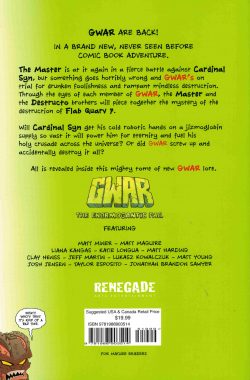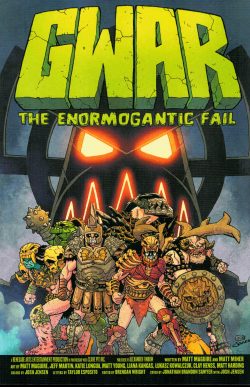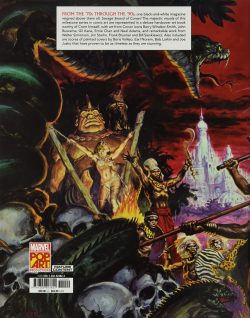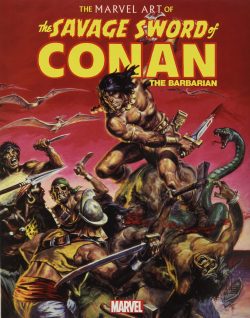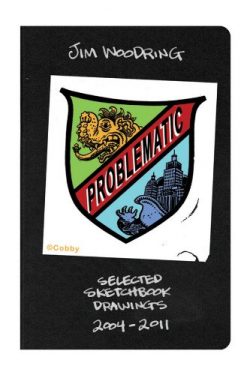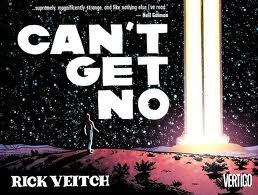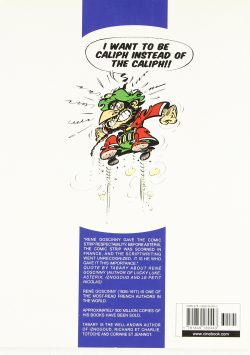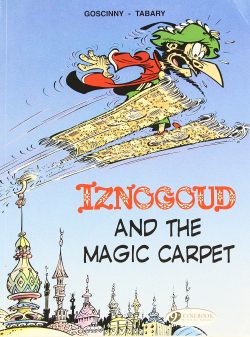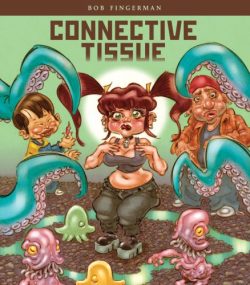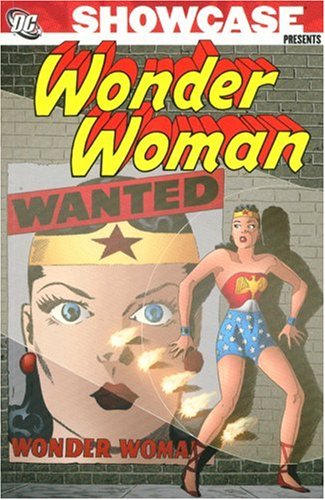
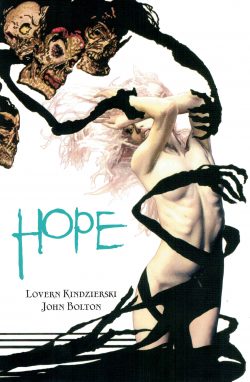


By Lovern Kindzierski, John Bolton & Todd Klein (Renegade Arts Entertainment)
ISBN: 978-1-98782-548-0 (Hope TPB) ISBN: 978-1-98890389-7 (Hell’s Flaw TPB)
Comics are unequivocally a visual medium and that’s never more ably demonstrated than in a seductively bewitching allegorical fable from writer Lovern Kindzierski, painter John Bolton and letterer Todd Klein.
The story began with three Original Graphic Novels released between 2011 and 2013, before the entire epic was housed in its proper setting: a lavish and sublime full-colour hardback tome, liberally garnished with beguiling bonus features and all the usual digital equivalents.
So, if you’re sitting comfortably with all the doors locked and windows covered, let’s begin with a swift reprise…
Once upon a time in Conception a benevolent but homely witch named Mother Virtue spent all her days doing little favours and grand good deeds for the ordinary and unfortunate, and for these kind actions she was beloved by all. Spiritually, she was probably the most perfect woman in the world, but as for her looks…
She lived life well, growing old and content, but one day, after decades of joyous philanthropy, a single selfish thought flashed idly through her mind: a momentary longing for a daughter and wish for it to be true, that she might be a mother in fact as well as name…
The weak moment was instantly exploited by malign Shadow of Ignorance Slur. Through dark magics, he impregnated the champion of Good with a vile seed of evil, bragging to the wise-woman that her wish-made daughter would be a diabolical demon deserving the name Shame…
Deeply repenting that selfish whim and dreading horrors yet to come, Mother Virtue transformed her idyllic cottage in the woods into a floral prison; a Cradle reluctantly repurposed to isolate and eventually contain the thing growing in her belly. The miserable matron-to-be also assembled Dryads to care for and guard the baby. Once Virtue finally births Shame, she leaves the devil’s burden to be reared in the mystical compound, where it grows strong and cruel but so very beautiful…
After much concentrated effort, however, minions of Shame’s sire breach Cradle’s green ramparts and school the child in vile necromancy to ensure her dire, sordid inheritance. With malefic potency, Shame refashions her guardians into something more pliable and appropriately monstrous…
As the devil’s daughter physically ripens, Slur himself comes to his evil child and through him Shame learns the terrifying power of sex. With the aid of an infernal incubus which has stolen seed from many men, she quickens a child in her own belly and eventually births a beautiful baby girl.
Into that infant Slur pours Mother Virtue’s soul; gorily ripped from the despondent dotard’s aging carcase at the moment of her granddaughter’s delivery. Even the nunnery Virtue had locked herself within was no proof against the marauding Shadow of Ignorance…
With her despised mother now her own child, securely bound within the floral penitentiary, Shame goes out into the world to make her mark…
Pursuit took up the story sixteen years later. Infant Virtue has grown strong and lovely, despite every effort of malformed, mystically mutated Dryads and Shame’s own diabolical sorcery toiling constantly but to no effect in a campaign of corruption, making every day of her young life a savage test of survival. This daily failure makes Shame – now elevated by her own evil efforts to queen of a mortal kingdom – furious beyond belief.
When not burning witches and wise women who might threaten her absolute domination, or having her armies ravage neighbouring realms, the haughty hell-spawn spies upon her offspring/ancestor with infernal devices, but is always bitterly disappointed and enraged….
Elsewhere, a valiant knight lies dying and mournfully bids his afflicted son Merritt farewell. With his last breaths, the swift-failing father dreads how his foolish, naïve, beloved boy will fare in a world ruled by the Queen who has ended him…
The hopeless dreamer is stubborn above all else and – when Merritt discovers the vegetable hell-mound of Cradle – stories his mother told him long ago run again through his head. Odd, inexplicable yearning compels him to overcome appalling arcane odds and break in. He liberates the beautiful prisoner… although she actually does most of the work…
Freed from Cradle, Virtue’s mystic might blooms. Far away, Shame reels. Slur cares little for his daughter but much for his plans: disclosing Merritt is Destiny’s wild card: a Sword of Fate who could reshape the future of humanity. Of course, that depends on whose side he joins…
The young heroes near the capital but are ambushed. After a tremendous mystic clash, Merritt awakens in a palace with a compelling dark-haired vision ministering to his every need and desire. Meanwhile, far below in a rank, eldritch dungeon, Virtue languishes, patiently adjusting plans…
This eldritch esoterically erotic epic concluded with Redemption as Merritt fell deeper under the sultry sway of the dark queen, devolving into her submissive tool of human subjugation, whilst Virtue languished in fetid squalor, weaving intricate magic with the paltry, debased materials at hand…
In the Queen’s arms, Merritt remains a child shaped by his mother’s bedtime stories. When Virtue contacts him, he readily sneaks down to her cell, dreams of nobility and valiant deeds filling his addled head…
With a final confrontation between mother and daughter imminent, Virtue sends Merritt to Hell on a vital quest to recover the Hope of the World. His triumphant return saves the kingdom and redeems the downcast…
As with all great fairy tales, justice is delivered and the world is set right side up again, with Shame dead, Slur confined to the Pit and pure reborn soul Hope in charge…
But what actually happens on the first day of “Happy Ever After� The answer comes as the initial trilogy is extended via a second tranche of Original Graphic Novels, with Kindzierski & Bolton picking up their eldritch tapestry again in Hope…
The day after Shame’s dismemberment and descent to Hell, chaos and uprising grips the kingdom, forcing Merritt and rebel wisewoman Miss Grace to escort bewildered Hope to safety outside the castle. The war has been won but evil cannot die and the rioting crowds are almost as much a danger as the Queen’s remaining stooges and free-roaming satanic spirits. Moreover, the child’s unschooled mystic force makes her a danger to herself and all around her…
Transporting her to the peaceful countryside fills Merritt with memories of his childhood and reveals what happened to his own mother, subsequently provoking Grace to review her own chequered past. Both have suffered grievously from Shame’s actions, and have no idea that the monster is still active in Hell, manipulating ghosts and demons to effect her return to Earth using the infernal contamination that used to be Cradle…
In the forests, Hope sees visions of forthcoming atrocity, which confirmed by Grace’s scrying, force the caravan to divert towards the once-green hell and meet the threat head on…
To Be Continued…
Fifth volume Hell’s Flaw resumes the epic quest, as Shame marshals her forces to secure the pathway from Hell to the living world, while the wary, weary band of heroes struggles to the verdant hellmouth.
Their way is blocked demonic forces too horrible to bear, but Grace has learned to tap Hope’s raw magic to fight them off. Slowly though, she becomes more controlling, her promises to teach the child somehow never materialising, although her need for her as a living battery constantly increases. Eventually, however, during a truly formidable assault, Hope asserts herself to save Merritt and the entire course of the quest changes…
In Hell, Shame’s own cunning endeavours have borne black fruit and she is ready to return…
To Be Concluded…
Epic and fanciful, the fairy tale trappings mask a most mature examination of Good and Evil, and the shimmering photorealistic expressionism of John Bolton’s lush painting transforms the familiar settings of fantasy standards and set-pieces into visions truly bleak and bizarre, perfectly complementing the grim, earthily seedy meta-reality of Kindzierski’s script.
Dark and nasty yet packed with sumptuous seductions of every stripe, the salutary saga of Shame is every adult fantasist’s desire made real and every comic fan’s most fervent anticipation in one irresistible package…
Hope, Hell’s Flaw and Shame: the series conceived and written by Lovern Kindzierski. The story, characters, world and designs are © Lovern Kindzierski, John Bolton and Renegade Arts Canmore Ltd.
